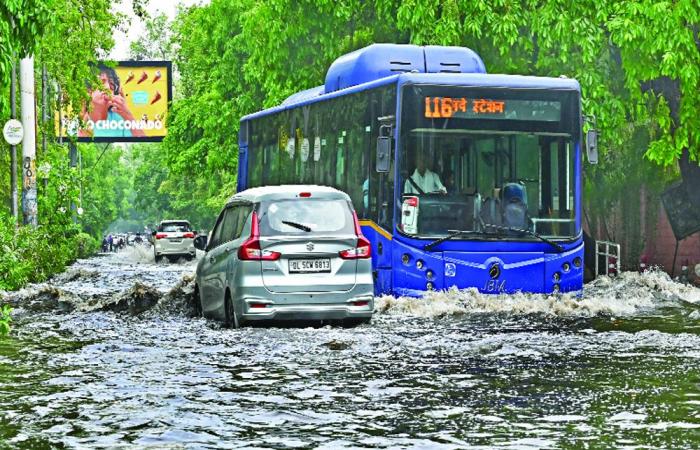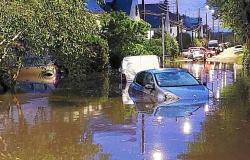What initially felt like relief from scorching temperatures quickly spiralled into a climate disaster, paralysing infrastructure, claiming lives, and laying bare the capital’s deep vulnerabilities in the face of increasingly erratic weather patterns driven by climate change
Delhi, which is still recuperating from a severe heatwave that drove temperatures near 50°C, experienced another unexpected weather event this week — a sudden and unprecedented downpour that brought large parts of the capital to a halt. Within just 24 hours, Delhi recorded 228.1 mm of rainfall, exceeding the city’s typical total for the entire month of June by over three times. The intense rain resulted in widespread waterlogging, traffic congestion, cancellation of several flights, infrastructural damage, and even fatalities. In one heartbreaking instance, four individuals lost their lives when a tree fell on a house during the storm.
What began as a respite from the extreme heat quickly turned into a disaster. This extreme occurrence prompts urgent questions regarding the city’s capacity to manage such climatic
challenges. It underscores the vulnerability of Delhi’s infrastructure and the inadequate preparation we have to confront the increasing effects of climate change.
Experts indicate that climate change is a significant factor contributing to the occurrence of such heavy rainfall events. As global temperatures increase, the atmosphere retains more moisture, resulting in brief yet extremely intense rain showers. This pattern is predicted to become more frequent, particularly in densely populated cities like Delhi, which are dealing with haphazard development and insufficient green spaces.
The urban heat island effect also plays an important role in such extreme weather events. With extensive concrete areas and limited vegetation, Delhi tends to retain heat, which can lead to localised weather disturbances, exacerbating the rainfall’s effects.
The rapid expansion of the city has additionally put pressure on its natural drainage systems. Many drains are blocked with plastic and waste, and numerous natural watercourses have
been covered over or encroached upon. These issues diminish the city’s capacity to absorb rainfall, turning even moderate rainfall into a flood-like situation.
Inadequate drainage, decreasing green areas, and poor urban planning render Delhi particularly susceptible. Much of the city is covered with concrete, hindering water from infiltrating the soil. Consequently, rainwater has no place to go. When intense rainfall occurs, it overwhelms the drainage system, resulting in road flooding and disrupting transportation and daily activities.
To address this issue, urgent actions need to be implemented. All drainage systems must be cleared before the onset of the monsoon season. Areas prone to flooding should be pinpointed, and effective flood management solutions should be established.
Emergency services must receive training and be prepared, while timely and extensive public alerts regarding weather conditions and traffic must be communicated. Raising public awareness on actions to take and avoid during such events is equally crucial. Campaigns to educate people on safety measures during floods can contribute to saving lives and minimising damage. Individuals should be informed about secure routes, how to mitigate electrocution hazards, what essentials to keep accessible during emergencies, and how to assist others securely. Another significant concern that has arisen is the risk posed by trees falling during heavy rainfall. In the recent downpour on Friday, four individuals lost their lives due to such an occurrence.
This has turned into a persistent issue in Delhi. Many of the trees in the city are not well-suited to urban conditions. They are planted in limited spaces surrounded by concrete, which impedes root development. Over time, this contributes to their weakness and instability. Without appropriate maintenance or evaluation, these trees turn into a hidden danger to both life and property during storms. The Government must promptly carry out an assessment to pinpoint trees that are at risk of toppling. Ageing and poorly anchored trees should be either removed or reinforced. Future planting efforts should emphasise native species that are more compatible with Delhi’s climate. Sufficient open space around trees is crucial for robust root growth.
In the future, Delhi requires a comprehensive strategy to address disasters — particularly those related to climate change. The city’s disaster management initiatives must conform to the global Sendai Framework for Disaster Risk Reduction, which highlights four essential priority areas for action. To begin with, Delhi should enhance its comprehension of disaster risks. This involves improving weather prediction, risk assessment, and early alert systems. Every public service department needs to recognise the risks and be trained for prompt action.
Next, there should be stronger collaboration among Government agencies. No single organisation can manage disaster risk reduction alone. All departments — such as municipal services, healthcare, transportation, education, law enforcement, and others — must cooperate. Each department should develop its disaster management plan, defining its roles and responsibilities before, during and after a disaster, accompanied by standard operating procedures that are implemented when a disaster is anticipated.
Furthermore, the city needs to invest in improved infrastructure. This encompasses stormwater drainage systems, flood defences, more robust roads and buildings, and the establishment of parks and ponds to handle excess water. Nature-based solutions, like wetland restoration and the preservation of green areas, can significantly help in minimising flood risks.
Lastly, disaster readiness should be enhanced at all levels. Routine mock drills, training sessions, and public awareness initiatives should be carried out. Communities need to be equipped with the necessary skills and knowledge to respond effectively during emergencies. In any disaster scenario, the community acts as the first line of defence. Well-informed and trained citizens can greatly help in decreasing casualties and damages.
To implement these ideas, Delhi requires a comprehensive and practical action strategy. This strategy should detail specific measures for each of the four key focus areas, designate responsibilities to various departments, and create a clear protocol for response. Once a weather alert is issued, departments should avoid delays due to meetings. They must adhere to a predetermined course of action to minimise confusion and safeguard lives.
Collaborating with national organisations such as the India Meteorological Department and the National Disaster Management Authority is essential. By sharing information, coordinating plans, and responding together, the overall effectiveness of disaster management can be greatly enhanced.
The increasing challenges climate change poses necessitate a shift from reactive responses to proactive planning. Delhi must prepare itself to withstand nature’s onslaught instead of being caught unprepared repeatedly.
Given the densely populated areas, ageing infrastructure, and erratic weather patterns, the capital needs to foster resilience immediately. The recent rainfall disaster should serve as a pivotal moment. It has highlighted the ramifications of unprepared urban environments when faced with natural events.
If action is not taken promptly, these disasters will only escalate in severity and frequency. Now is the time for Delhi to focus on preparation — not just in response, but also in prevention and building resilience. Strategies involving planning, coordination, investment, and public education are crucial tools to safeguard the capital in the future.
(The writer is former Executive Director, National Institute of Disaster Management, Government of India; and former Director, SAARC Disaster Management Centre. Views are personal)







